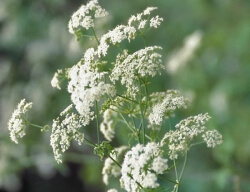
Conium maculatum
Poison hemlock brochure (PDF)
Why is poison hemlock a problem?
Poison hemlock is an aggressive, invasive species. The entire plant is toxic to animals and humans, containing the poisonous alkaloid coniine and other alkaloids.
These poisonous compounds can affect the nervous system. Initial symptoms may include a burning sensation in the mouth, nausea, vomiting and confusion. Death, when it occurs, is usually rapid and is caused by respiratory paralysis.
Livestock can suffer from birth defects if poison hemlock is ingested. Birth defects typically occur in calves and piglets and may include crooked legs, cleft palates and kinked tails.
Poison hemlock was introduced into North America from Europe, where it is native. It has become well established in all regions except desert. Seeds can be spread by human activities, animals, water, vehicles and the movement of soil.
Recommendations for controlling poison hemlock
Recognizing poison hemlock
Poison hemlock can be mistaken for many edible and ornamental members of the carrot family, such as parsley and wild carrot.
Poison hemlock is a tall biennial plant that can grow up to 12 feet in height. It produces flowers that are small, white and occur in 4 to 8 inch umbrella-shaped clusters.
Seedlings emerge in spring and grow into a rosette the first year. Similar regrowth can take place in the early fall. In the spring of the second year, flowering stems are developed. Fern-like leaves are glossy green, finely divided, smooth and hairless. Leaves have a strong odor when crushed. Stems are hollow, smooth and hairless and have distinctive purple blotches.
Poison hemlock prefers rich, moist soil, but is highly adaptable to other conditions. It is commonly found in stream banks, vacant lots, roadsides, pastures and meadows. The plant reproduces by seed and can produce up to 1,000 seeds.
